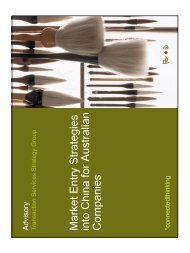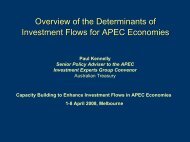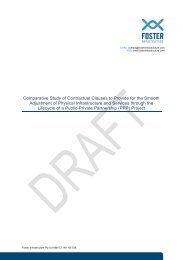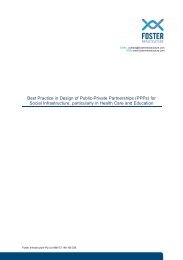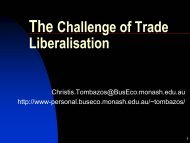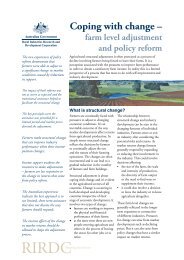THE DRIVERS OF COMPETITIVENESS IN MALAYSIA By Mohamed ...
THE DRIVERS OF COMPETITIVENESS IN MALAYSIA By Mohamed ...
THE DRIVERS OF COMPETITIVENESS IN MALAYSIA By Mohamed ...
You also want an ePaper? Increase the reach of your titles
YUMPU automatically turns print PDFs into web optimized ePapers that Google loves.
<strong>THE</strong> <strong>DRIVERS</strong> <strong>OF</strong> <strong>COMPETITIVENESS</strong> <strong>IN</strong> <strong>MALAYSIA</strong><strong>By</strong> <strong>Mohamed</strong> AriffThe term “competitiveness” has many meanings. To the OECD, the competitiveness ofthe nations is a measure of meeting the test of international markets. The InternationalInstitute for Management Development (IMD) describes it primarily as the ability of anation to create and maintain an environment for wealth creation. The World EconomicForum (WEF) views it essentially as a means to ensure sustained growth in income percapita. To consumers all this means more value for money.In Malaysia, competitiveness is taken very seriously. To guarantee rising living standardsand economic prosperity, the nation has no choice but remain competitive in this era ofglobalisation and trade liberalisation. To be sure, it is not nations but companies thatcompete in the global arena. Nonetheless, the fact remains that the enterprises thatcompete internationally are conditioned by their home environment in which theyoperate. The Malaysian Government, accordingly, is bent on providing a policyenvironment that will enable its enterprises to compete effectively in the internationalmarket place. These include measures to streamline the country’s civil service withgreater transparency and better delivery systems.Needless to say, Malaysia is not an average developing country by any measure.Malaysia is the fourth most open economy in the world with exports and importsaccounting for over 200 per cent of its total gross domestic product (GDP). Trade is thelifeblood of the Malaysian economy. Foreign direct investment (FDI) has long been itsbackbone. Economic openness has brought much prosperity to this multi-racial country,as evidenced by the rapid pace of economic growth and development since Independencein 1957. It is noteworthy that the country’s per capita income now exceeds US$4,000mark, placing Malaysia in the league of the advanced developing economies. It ispertinent to mention in passing that Malaysia is Australia’s 10 th largest trading partnerand that Australia is Malaysia’s 14 th largest trading partner.
Malaysia has done fairly well in terms of competitiveness. It is worth noting that theIMD, in its World Competitiveness Yearbook 2004, has given Malaysia a reasonablyhigh rating. Malaysia’s overall ranking jumped to 16 in 2004 from 21 in 2003. Amongthe economies with population exceeding 20 million, Malaysia is ranked fifth in 2004compared with its seventh position in the preceding year. Within the Asia-Pacific region,Malaysia is the fifth most competitive economy after Singapore, Australia, Hong Kongand Taiwan.While all this sounds reassuring, if not flattering, there is absolutely no space forcomplacency of any sort. International competition is getting stiffer as globalisation andtrade liberalisation gathers momentum. The Malaysian industries are facing increasinglytough competition not only abroad but also at home, as domestic trade barriers getsdismantled through regional and bilateral free trade agreements (FTAs), not to mentionthe ongoing multilateral negotiations under the auspices of the World Trade Organization(WTO). Import substitution is not an option any more, now that it is already difficult toprotect domestic production against international competition in the era of globalisationand regional economic integration. Export orientation is not going to be easy either, withmore and more countries joining the bandwagon in the pursuit of export-led economicgrowth.Malaysia’s comparative advantage in unskilled labour intensive manufacturing has beeneroded by the entry of low-wage countries, especially China, into the foray. GivenChina’s seemingly unlimited supply of cheap labour, it is quite conceivable that Chinawill enjoy competitive advantage in a wide range of products for a long time and becomethe factory for the whole world. However, it will take a while for China to realise its fullpotential. Although labour costs are low in China, many other costs, especiallytransaction costs, remain high, giving countries like Malaysia some breathing space fornow.The time has come for Malaysia to move away from low value-added labour-intensivemanufactures to high value-added skill-intensive and technology-intensive
manufacturing. This calls for increased science and technology (S&T) related investmentin human capital and research and development (R&D) activities. In the interim, viablealternatives to labour-intensive assembly activities include biotechnology, photonics andnanotechnology, especially in the areas of micro-electro-mechanical system (MEMS),advanced electronic displays, high density data storage and conductive polymers. In theelectronics sector, there is considerable room for Malaysia to move up the value chain.The time has also come for the Malaysian automotive industry to take a spin, allowingthe global manufacturers of motor vehicles to share the centrestage with the nationalcarmakers. Under the ASEAN Free Trade Area (AFTA), the national carmakers will facetough competition especially from Thailand, which is emerging, by default, as the Detroitof Southeast Asia. Arguably, Malaysia is better equipped in terms of industrialinfrastructure to play this role. Additionally, Malaysia has the largest passenger carmarket in ASEAN. Malaysia will be able to gain a lot, if it can encourage some majorglobal manufacturers of automobiles to use Malaysia as their regional base. This will alsobe a boon for the Malaysian small and medium enterprises (SMEs) in the componentsand parts industry.The Proton’s domestic market share has fallen from over 65 per cent in 1999 to 44 percent in 2004. All indications are that this downtrend will continue, as the Malaysian carmarket becomes increasingly open. It is time for the auto industry to think out of the box.It is time for lateral, not linear, thinking. For there is considerable scope for regionalspecialisation in the automotive sector, with Malaysia concentrating on passenger carsand Thailand on commercial vehicles. Within the passenger cars segment, furtherdivision of labour for Malaysia and Indonesia is not unthinkable, with Malaysia focussingon bigger models and Indonesia on smaller makes.In the long term, it is advisable for Malaysia to avoid a collision course with China, notonly because an all-out direct competition with China will be suicidal, but also becausethe costs in terms of forgone opportunities will be enormous. It will be wiser for Malaysiato make its own economy complementary to that of China so that it can ride on the
latter’s coat tails. Seen in these terms, China is a land of opportunity, not a source ofthreat. To be sure, China is not the only country that is changing the globalmanufacturing landscape. There are other players to watch out for, including India,Thailand, Vietnam and the Philippines.The manufacturing sector may not remain the number one engine of growth for theMalaysian economy for long. The services sector is poised to play a lead role in theforeseeable future. Already, the share of services in GDP has risen from 50.7 per cent in1995 to 57.6 per cent in 2003. Tourism has emerged as the second largest foreignexchange earner after manufactures with tourist inflows of 14 million a year. Thegrowing regional demand for manufacturing-related services and education, healthcare,and financial services augurs well for Malaysia’s services sector. However, the servicessector is likely to play a relatively lesser role in Malaysia than it does in smallereconomies like Singapore, as the former has options not available to the latter. In otherwords, manufacturing will remain a major growth engine for the Malaysian economy forquite some time, although it will have to re-invent itself by shifting to the upper end ofthe value chain, producing skill- and technology-intensive goods for niche markets.Like manufactures, services too will face an increasingly competitive environment bothat home and abroad. India is likely to emerge as the largest provider of services. Here toothere is a need for Malaysia to avoid a collision course, with Malaysia forging strategicalliances with top-notch players in India. There are turf in which India cannot bechallenged, especially in the information technology (IT) software, but Malaysia caninitiate joint ventures, rather than compete head-on, with Indian companies such as Wiproand Satyam in the realm of business process outsourcing (BPO). It is encouraging to notethat A.T. Kearney’s Offshore Location Attractiveness Index 2004 has ranked Malaysiathird after India and China as investment destinations for outsourcing.Malaysia’s heavy investments in the development of the Multimedia Super Corridor(MSC) in 1996 is beginning to produce results. The number of companies in the MSC hasgrown from 94 in 1997 to 1,067 in 2004. The number of multinationals (MNCs)
operating in the MSC has increased from 13 in 1997 to 65 in 2004. It is noteworthy thatMotorola, Ericsson, IBM, Shell, DHL, HSBC and BMW have located their regionaloffshore service centres in the MSC. The flagship IT applications by MSC companiescover (a) electronic government, (b) smart card, (c) smart schools, (d)telemedicine (e)R&D cluster, (f) e-business and (g) technopreneur development.The Abdullah Badawi administration attaches much importance to the development ofsmall and medium enterprises (SMEs). According to the Companies Commission ofMalaysia (CCM), there are 40,655 SMEs in the country, accounting for 29.1 per cent ofthe country’s manufacturing output, 26.1 per cent of manufacturing value added and 32.5per cent of manufacturing employment in 2003. It is of interest to note that, in 2003,SMEs directly exported 26.5 per cent of their output. In terms of capital intensity,however, the SMEs lag behind the manufacturing sector average, with fixed assets perworker standing at RM35,792, which falls short of the manufacturing sector’s average ofRM49,117 in 2003. It is encouraging to note that the Malaysian SMEs have beenregistering double-digit growth in value-added terms in a variety of industries in recentyears. The Malaysian Government has put in place a number of programmes to bolsterSMEs and these include Industrial Linkage Programme, Global Supplier Programme andSkills Upgrading Programme. More recently the Government has set up the NationalSME Development Council to chart out new directions and strategies for SMEs. What ismore, there are plans to establish SME Development Bank to cater specifically to thefinancial needs of SMEs.The Malaysian Government, under the present administration, has laid considerableemphasis also on modernising the agricultural sector through S&T applications thatwould raise productivity and profitability in the sector. It is hard to imagine a dynamicagricultural sector in the country in the absence of foreign investment in the sector, whichhowever would raise such thorny issues as land reforms and property rights. It is alsohard to imagine a competitive agricultural food sector in Malaysia now that land andlabour, key factors of production in agriculture, are more costly in Malaysia than in theneighbouring countries, unless this disadvantage can be more than offset by quantum leap
at the technological front. Under AFTA, it will be profitable for Malaysia to concentrateon food manufacturing, importing raw materials from regional sources at lower costsinstead of producing them all at home. There is a lot to gain by focussing on high valueaddeddownstream food processing and manufacturing rather than on primary production.Needless to say, there is much more to agriculture than just food crops. Malaysia is alsotargeting at fishery, herbal medicine, palm-oil based fuel, etc. What is in Prime MinisterAbdullah Badawi’s vision for agriculture is not traditional agriculture but technologydriven“value adding” to agricultural produces.The production of “halal” food, in particular, has exciting prospects in Muslim societies.Malaysia has the credentials and capabilities to be a major halal food production base forthe entire Muslim world. Here again, it will not pay Malaysia to go it alone. Malaysia cansource inputs from the region more cheaply than producing them domestically. Malaysiahas not been very successful in its attempts to establish economically viable livestockfarms in the country. Malaysia can team up with Australia and New Zealand in producingmeat-based halal products. Export potentials for halal food are huge by any measure.Thus, halal food production can add a powerful new cylinder to the growth engine of theMalaysian economy.Post-1997/98 crisis figures do show a slower growth rate for all sectors except agriculturecompared to the pre-crisis benchmarks. During 1999-2004, manufacturing grew at anaverage rate of 7.6 per cent, down from 12.3 per cent growth in 1991-97. The pace ofexpansion was the slowest in the construction sector in 1999-2004 at 0.5 per cent, whichpales in comparison with 14.2 per cent in 1991-97. The corresponding figures forbusiness and non-government services were 7.3 per cent and 11.8 per cent, respectively.The only exception, as mentioned, was agriculture with an average post-crisis growth of2.8 per cent, up from the pre-crisis low of 0.6 per cent, but still considerably lower thanthat of manufacturing, mining and services.Experience has shown that input-driven growth is not sustainable, as there are limits tothe additions of capital and labour. Hence the importance of productivity-driven growth.
Total factor productivity (TFP), which represents the residual after accounting for thecontributions of incremental capital and labour inputs, is a useful measure ofcompetitiveness. The 1997/98 crisis is partly explained by the loss of competitiveness ofEast Asian exports. There is a close correlation between export competitiveness and TFPgrowth. In Malaysia, TFP growth was shrinking from 1994, with negative growth in 1998and 2001. Since then Malaysia’s TFP growth has been clearly trending up.The National Productivity Corporation (NPC) has stepped up efforts to improveproductivity and quality across industries, both manufacturing and services. Recent datado show encouraging trends in productivity on a wide range of activities. While suchrelentless efforts must continue as a major driver of competitiveness, Malaysiancompanies need to forge strategic alliances with others in the region and elsewhere. Afterall, it is companies, not countries, which compete internationally. The Government willhave to focus increasingly on creating a business environment for enterprises to bring outthe best in them. ASEAN economic integration and bilateral free trade agreementsprovide valuable opportunities for Malaysian companies to spread their wings far andwide.The time has come for Malaysia to move up the value chain. Although there is evidenceof this happening already, Malaysia has a long way to go. The level of R&D expenditureis still disappointingly low in Malaysia. In 2002, R&D expenditure amounted to only 0.7per cent of Malaysia’s GDP, which pales in comparison with Japan’s 3.1 per cent, USA’s2.7 per cent, Korea’s 2.5 per cent, Taiwan’s 2.3 per cent and Australia’s 1.5 per cent. In2002, the number of researchers per 10,000 labour force stood at 18 in Malaysia, whichcompares poorly with 120 in Denmark, 113 in Japan, 99 in Australia, and 90 in theUnited States. Enhancing the country’s R&D capabilities is high on the MalaysianGovernment’s agenda.Competitiveness based on undervalued exchange rate is unsustainable. Malaysia’s fixedexchange rate regime has apparently worked in favour of Malaysian exports, as the USdollar, to which the Malaysian ringgit is tied, has been depreciating significantly since
2002. In Malaysia, the cheap ringgit is generally seen as a “plus point” contributing to thecountry’s export competitiveness. Little is realized how dangerous it is to rely on cheapcurrency for competitiveness. For undervalued currency also means increased cost ofimports and higher domestic prices. The rising cost of imports and domestic inflation willeventually negate the competitive advantage attributed to the undervalued exchange rate,given the high import content of manufactured exports. The futility of this strategy is thusreadily obvious. However, there are fears in Malaysia that a sudden currency appreciationwill hurt Malaysian exports. Yes, it certainly will, but the loss of export competitivenesswill be temporary. As the currency appreciates, imports will become cheaper andinflation will subside, reversing the initial adverse impact. For competitiveness, one mustturn to innovations, cost reductions, productivity improvements, new processes, and newproducts.In the final analysis, it is the quality of the workforce that will make the real difference.The human factor plays a pivotal role. First-world infrastructure with third-worldmentality will not produce the desired results, as Prime Minister Abdullah Badawi haswarned. Investments in education, training and skill development will determine thecapacity of a nation to change with changing times. As mentioned, it is companies, notcountries that compete in the market place. <strong>By</strong> the same token, it is human capital, notphysical capital that is crucial to the competitiveness of these enterprises. It is hearteningthat Malaysia is investing increasingly in human resource development instead of beingpreoccupied with infrastructure development.







